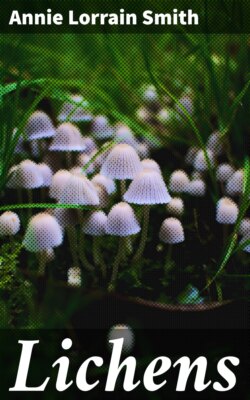Читать книгу Lichens - Annie Lorrain Smith - Страница 73
На сайте Литреса книга снята с продажи.
E. Rooting Base in Fruticose Lichens
ОглавлениеFruticose and filamentous lichens are distinguished by their mode of attachment to the substratum: instead of a system of rhizinae or of hairs spread over a large area, there is usually one definite rooting base by which the plant maintains its hold on the support.
Intermediate between the foliose and fruticose types of thallus are several species which are decumbent in habit, but which are attached at one (or sometimes more) definite points, with but little penetration of the underlying substance. One such lichen, Evernia furfuracea, has been classified now as foliose, and again as fruticose. The earliest stage of the thallus is in the form of a rosette-like sheath which bears rhizinae on the under surface, very numerous at the centre of the sheath, but entirely wanting towards the periphery. A secondary thallus of strap-shaped rather narrow fronds rises from the sheath and increases by irregular dichotomous branching. These branches, which are considered by Zopf[384] as adventitious, may also come into contact with the substratum and produce a few rhizinae at that point; or if the frond is more closely applied, the irritation thus produced causes a still greater outgrowth of rhizinae and the formation of a new base from which other fronds originate. These renewed centres of growth are not of very frequent occurrence; they were first observed and described by Lindau[385] in another species, Evernia prunastri, and were aptly compared by him to the creeping stolons of flowering plants.
Evernia furfuracea grows frequently on dead wood, palings, etc., as well as on trees. E. prunastri grows invariably on trees, and has a more constantly upright fruticose habit; in this species also, a basal sheath is present, and the attachment is secured by means of rhizoidal hyphae which penetrate deeply into the periderm of the tree, taking advantage of the openings afforded by the lenticels. The sheath hyphae are continuous with the medullary hyphae of the frond, and gonidia are frequently enclosed in the tissues; the sheath spreads to some extent over the surface of the bark, and round the base of the fronds, thus rendering the attachment of the lichen to the tree doubly secure.
Among Ramalinae, the development of the base was followed by Brandt[386] in one species, R. Landroensis, an arboreal lichen from S. Tyrol. A rosette-like sheath was formed consisting solely of strands of thick-walled hyphae which spread over the bark. There were no gonidia included in the tissue.
A different type of attachment was found by Lilian Porter[387] in corticolous Ramalinae—R. fraxinea, R. fastigiata, and R. pollinaria. The lichens were anchored to the tree by strands of closely compacted hyphae longitudinally arranged and continuous with the cortical hyphae. These enter the periderm of the tree by cracks or lenticels, and by wedge action cause extensive splitting. The strands may also spread horizontally and give rise to new plants. The living tissues of the tree were thus penetrated and injured, and there was evidence that hypertrophied tissue was formed and caused erosion of the wood.
